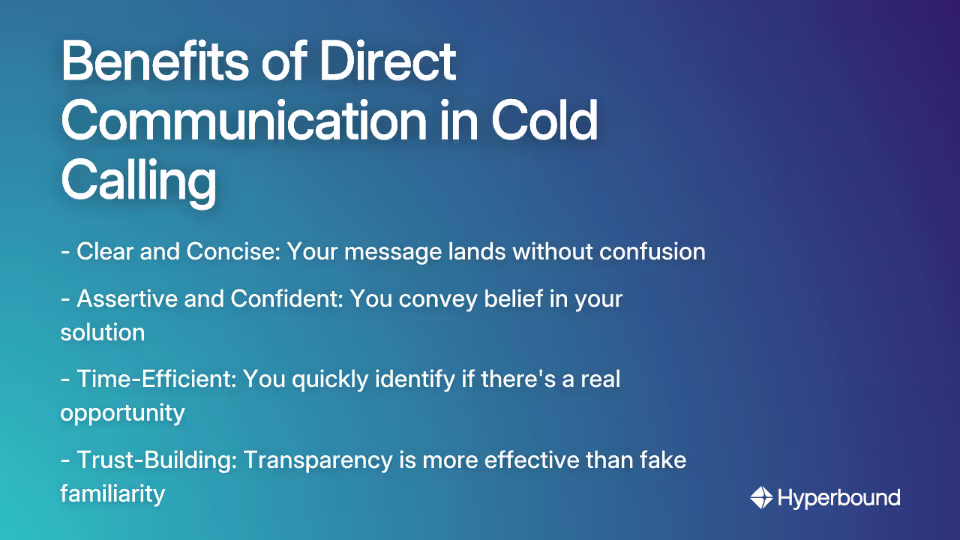%20copy.avif)
You pick up the phone, the prospect answers, and the clock starts ticking. What do you say? Many BDRs default to "How are you?" or "Did I catch you at a bad time?" while cringing internally. You can almost hear the prospect's eyes roll over the phone.
This awkward dance at the beginning of a cold call is a universal pain point for salespeople. You want to build rapport, but you also know that traditional small talk often feels insincere and backfires.
The good news? A direct, no-nonsense approach isn't just more effective—it's actually more respectful of your prospect's time. With 57% of C-level executives preferring cold calls for initial contact, mastering the opener isn't optional—it's essential to your success as a BDR or sales professional.
Why Your "Polite" Opener is Killing Your Calls
Let's look at what the data actually says about those "polite" openers you've been taught to use.
A widely-cited study analyzed over 300 million cold calls to determine which openers work and which fall flat. These are the kinds of data-backed insights that platforms like Hyperbound use to power AI-driven sales coaching. The results might surprise you:
The Worst Offenders:
"How's your day going?"
- Success rate: A dismal 7.6%
- Why it fails: Your prospect immediately recognizes this as a generic telemarketer script. Their defense mechanisms activate, and the call is effectively over before it begins.
"Did I catch you at a bad time?"
- Success rate: Even worse at 2.15%
- Why it fails: This opener frames your call as an interruption (which it is) and suggests you lack confidence in your own value proposition. As one sales professional on Reddit put it: "I've stopped apologizing for my call and I find it more effective."
By starting with these fluff-filled openers, you're not building rapport—you're damaging it.
The Power of Direct Communication: Respecting Time & Building Trust
Direct communication isn't about being rude—it's about being professional. In a business context, straightforward exchanges minimize misunderstanding and demonstrate respect for the prospect's time.
For a BDR, this approach offers several advantages:

- Clear and Concise: Your message lands without confusion
- Assertive and Confident: You convey belief in your solution
- Time-Efficient: You quickly identify if there's a real opportunity
From the prospect's perspective, directness is refreshing. They appreciate your transparency, which builds trust faster than feigned familiarity. As one sales professional noted, "I try to meet them on a human level—not trick them into listening to me."
Remember the sales mantra: "Get through the no's quickly so you can get to a solid yes." A direct opener helps you do exactly that.
No-Fluff Cold Call Scripts That Get to the Point
Let's dive into some proven openers that skip the fluff and get straight to business. Remember, there's no one-size-fits-all script—these should be adapted to your specific situation and industry.
1. The Permission-Based Opener
Success Rate: 11.18% (According to the study)
"Hi [Prospect Name], this is [Your Name] with [Your Company]. I know you weren't expecting my call, so I'll be brief. This is a cold call. Would you be opposed to me taking 30 seconds to explain why I'm calling, and then you can let me know if it makes sense to talk further?"
Why it works:
- It acknowledges the reality of the situation
- It respects the prospect's time with a specific timeframe
- It gives the prospect control, which paradoxically makes them more likely to listen
2. The Contextual Opener
Success Rate: 11.24% (The highest-performing opener in the same research)
"Hi [Prospect Name], my name is [Your Name]. We work with other [Prospect's Job Title] at companies like [Similar Company 1] and [Similar Company 2]. I was curious, have you heard our name tossed around in your circles?"
Why it works:
- It immediately establishes relevance through social proof
- It creates curiosity with a pattern-interrupt question
- It positions you as someone who works in their industry, not just a random caller
3. The Direct Value Prop Opener
"Hi [Prospect Name], it's [Your Name] from [Your Company]. The reason I'm calling is we've helped other companies in the [Prospect's Industry] industry to [achieve specific result, e.g., cut cloud computing costs by 30%]. Is solving [specific pain point] a priority for you right now?"
Why it works:
- It immediately addresses what's in it for them
- It demonstrates you've done your homework
- It qualifies the prospect by asking about their priorities
4. The Pattern Interrupt Opener
"Hi [Prospect Name], I know I'm probably the last person you wanted to hear from today, and I can explain why I'm calling in just 27 seconds. If at the end of that you're not interested, you have my permission to hang up. Sound fair?"
Why it works:
- It uses self-awareness and humor to disarm the prospect
- The specific timeframe (27 seconds, not 30) makes it memorable
- It empowers the prospect, which reduces resistance
One sales professional noted this approach "got them to listen to my pitch 95% of the time" because it establishes dynamics quickly and often gets prospects laughing.
When dealing with gatekeepers, a direct approach can be equally effective. Instead of trying to sneak past them, acknowledge their role: "I was hoping you could help me. I'm trying to reach the person who handles [specific responsibility]."

Best Practices for Delivering Your No-Fluff Opener

A great script delivered poorly is still a bad call. Here's how to make your direct opener land perfectly:
1. Do Your Homework First
A direct opener that references a pain point only works if you've actually done your research. Before making the call:
- Review the prospect's LinkedIn profile
- Check their company's recent news
- Look for trigger events in your CRM
- Understand industry-specific challenges
This preparation ensures your value prop is relevant and demonstrates you respect their time enough to come prepared.
2. Call at the Right Time
Timing matters. Data from Zendesk shows:
- Best days: Wednesdays and Thursdays
- Best times: 10-11 am and 4-5 pm
- Worst times: Monday mornings and Friday afternoons
Remember that it takes an average of eight call attempts to connect with a prospect, so persistence is key.
3. Master Your Tone and Pacing
Direct doesn't mean aggressive. Your tone should be:
- Clear and confident
- Conversational, not robotic
- Enthusiastic but not overly excited
The "rapport window"—those crucial first 7 seconds—is when prospects decide whether to engage or disengage. Speak clearly and at a slightly slower pace than normal conversation to ensure comprehension.
4. Be Prepared for Objection Handling
The opener is just the beginning. Be ready for common responses:
- "I'm not interested" - "I understand. Many of our best clients initially felt the same way. What specifically about [solution area] isn't a priority right now?"
- "We already have a solution" - "That's helpful to know. Most companies we work with had existing systems too. What aspects of your current solution are working well, and what could be improved?"
- "Just send me an email" - "I'd be happy to. To make sure I send something relevant, could you share what specific challenges you're facing with [area of focus]?"
5. Follow Through
Record every interaction in your CRM immediately after the call. Note specific pain points mentioned, objections raised, and any personal details that could help build rapport in future conversations.
Conclusion: From Interruption to Opportunity
By shifting from insincere small talk to a direct, value-driven approach, you transform the dynamic of the cold call from an unwanted interruption to a potential opportunity. This isn't just a tactic; it's a strategy built on transparency and confidence.
The most effective cold call openers respect the prospect's time, drop the fluff, and get straight to the point. This approach allows you to quickly identify genuine opportunities and move past dead ends—helping you get through the no's faster to find your yes.
Try implementing one of these direct openers for a week and track your conversion rate. You might be surprised at how prospects respond when you skip the small talk and lead with value.
Remember: In a world where everyone's inbox is overflowing and calendars are packed, respecting someone's time may be the most effective way to start building the trust that leads to closed deals.
Now pick up the phone and get to the point.
Frequently Asked Questions
What is the most effective cold call opener?
The most effective cold call openers are contextual and permission-based, with data showing success rates over 11%. These openers work because they immediately establish relevance or respectfully ask for a moment of the prospect's time. For example, a contextual opener like, "We work with other [Prospect's Job Title] at companies like [Similar Company]" builds social proof, while a permission-based opener like, "...would you be opposed to me taking 30 seconds to explain why I'm calling?" gives the prospect control, making them more likely to listen.
Why should I avoid common openers like "Did I catch you at a bad time?"
You should avoid openers like "Did I catch you at a bad time?" because they have extremely low success rates (under 3%) and immediately frame your call as an unimportant interruption. These phrases signal a lack of confidence in your value proposition and put prospects on the defensive. A direct, confident approach is more respectful of their time and more effective at starting a productive conversation.
How can I be direct on a cold call without sounding rude?
Being direct without being rude is about mastering your tone, pacing, and preparation. The goal is to be professional and confident, not aggressive or robotic. Your tone should be conversational and enthusiastic. Most importantly, do your research beforehand. A direct opener that mentions a relevant pain point or industry trend shows you've done your homework and respect the prospect's time, which is the opposite of being rude.
What is the best way to handle an immediate objection like "I'm not interested"?
The best way to handle an immediate objection is to acknowledge it calmly and then ask a clarifying question to understand the reason behind it. Instead of giving up, try responding with something like, "I understand. Many of our best clients felt the same way initially. To help me understand, what specifically about [your solution area] isn't a priority for you right now?" This response validates their feeling while gently probing for more information.
When is the best time of day to make cold calls?
According to research, the best times to make cold calls are typically mid-morning (10-11 am) and late afternoon (4-5 pm). These windows often catch prospects after they've settled into their day or as they're wrapping up. Wednesdays and Thursdays are generally the most effective days. However, persistence is key, as it often takes multiple attempts to connect with a prospect.
How should I adapt my opener for a gatekeeper?
Treat the gatekeeper as an ally, not an obstacle. Be direct, polite, and ask for their help. Instead of trying to trick or bypass them, acknowledge their role with a simple and effective approach like, "I was hoping you could help me. I'm trying to reach the person responsible for [specific area, e.g., managing cloud infrastructure]." This shows respect and often enlists their help in getting you to the right person.

Looking to improve your cold calling techniques even further? Check out these additional resources:
Book a demo with Hyperbound
.png)













